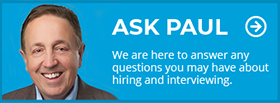Show Up, Line Up, Clean It Up: How candidates can stand out
Posted 9/16/2025

While it’s still a candidates’ market, it is a competitive one. Here are five important tips that can give you a competitive edge.
Tip #1: Keep your résume/CV to one page. A recent survey by Talent Works analyzed over 6,000 job applications from over 60 industries, and the average résume length was between 475 and 500 words. Focus your CV on the last 15 to 20 years of your job experience, because that’s what matters most to hiring managers on an initial review of your materials. Limit bullet points to no more than three to five for each role, and focus on accomplishments and achievements more than duties and responsibilities. If you positively impacted your company financially by an account you landed, a cost reduction you spearheaded, a new product you developed, or an increase in sales, this is the time to share it. Of course, use discretion not to divulge specific information that your company would not want publicized.
Tip #2: Add a professional photo to your LinkedIn profile. The overall quality of LinkedIn profile photos has improved over the last few years, so forego using that photo of you and a friend with a face cropped out. Also, the era of a selfie taken in front of a bathroom mirror has passed. Use a professional photographer—consider it an investment in your career—you’re worth it!
Tip #3: Include a physical address on your résume, not just name/phone/email. In this day of phishing and identity theft, you want to show you’re a real person living in a specific location. If you’re a candidate open to relocation, the past concerns about a city/state limiting your opportunities often no longer apply in this post-COVID-19 world, where remote work is an acceptable option for many positions.
An email takes more time to compose than a text and is a more fitting appreciation to an employer who has allocated time to meeting with you.
Tip #4: Ensure that your résume and LinkedIn profile align and tighten up your game in terms of job stays (starting/finishing), position titles, and basic responsibilities. Some of the common errors include lighting professionals who have listed a company on their résume that is not on their LinkedIn profile (or vice versa), detailing employment that significantly differs between résume and LinkedIn, and/or listing varying job titles for the same position. Many hiring managers can’t unsee these errors and inconsistencies, and they will bring those observations to your interview—if you’re even fortunate enough to get to the next step. Many decision makers view inconsistencies as a future preview of a candidate’s poor written communication, lack of attention to detail, or worse—an attempt to deliberately deceive or misrepresent one’s background to an employer.
Tip #5: In a world where texting is part of our everyday life, thank you notes following an interview should never be sent by text. Texted notes seem a little too casual, a bit cavalier. An email takes more time to compose than a text and is a more fitting appreciation to an employer who has allocated time to meeting with you. For something as “formal” as an interview, a texted thank you note can also feel intrusive.
Remember, the most successful candidate is not always the one whose résume most-closely matches the job description—ultimately, it’s about the person who best manages the interview process. In a competitive job searching landscape, details always matter, and these tips can help give you the edge to secure the job.
The In-Office Advantage
Many employees in the lighting and electrical industries enjoy the benefits of working remotely, either fully or in a hybrid capacity. However, those candidates willing to work in an office full time often have several advantages over a remote employee.
An office-based employee has a better chance of advancement than candidates working remotely. This may not be a popular concept, but high-performers have a better opportunity to demonstrate their abilities and talent in an environment where they can be seen every day.
In-office employees often develop a quicker—and better—rapport with their manager and peers. Microsoft Teams and Zoom are amazingly helpful tools, but they don’t replace the benefits of two people who are together in the same physical space regularly.
The ability to work with peers is much more evident in a person within the same physical location, as skills are demonstrated more viscerally on a day-to-day basis.
Staying informed about potential and/or future internal job openings (some of which may not be posted, but are discussed) is easier in the presence of your colleagues and management.
If you’re a high-producer, contributor, and play well with others, your stay at your company will often be longer than another employee with equal attributes who is working offsite. Whether fair or not, it stands to reason that in the event of downsizing, someone who is “out of sight, out of mind” likely has less job security during a period of layoffs than someone a manager sees and interacts with almost every day. (And aren’t we all more charming in person?)
These advantages do not mean that remote employees cannot—and will not—excel. However, it is important to understand there are often advantages to being physically present and visible daily in the workplace.



